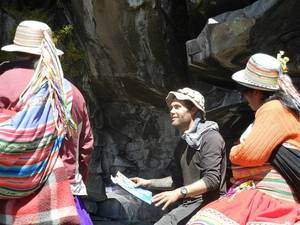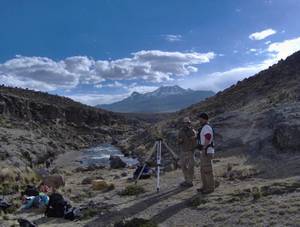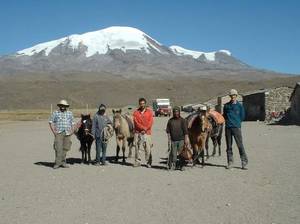Press Releases Archive
05.02.2014
Tübingen prehistory prize for Dr. Kurt Rademaker
Award for archaeologist who showed first humans in South America were quick to adapt to high altitudes
The 2014 Tübingen Prize for Early Prehistory and Quaternary Ecology goes to Dr. Kurt Rademaker (University of Maine) for his work on early human settlement of the high Andes, which showed that people adapted early to the harsh conditions at high altitudes in order to exploit resources there. He is the first person to win the prize for work done in the Americas.
The prize of €5000 is donated by mineral water producer Romina Mineralbrunnen GmbH. It is the richest annual prize of its kind for archaeologists. The award ceremony will take place on Thursday 6 February at 11am at Hohentübingen Castle. Media representatives are welcome to attend a press conference with Dr. Rademaker at 10am in the Institute of Prehistory and Medieval Archaeology, Schloss Hohentübingen, Room 101.
Kurt Rademaker received his bachelor’s degree in 1997 from the University of Kentucky, where he gained his first experience in Latin American archaeology at the site of Tres Zapotes in Veracruz, Mexico. In 2006 he completed a Master’s degree in Quaternary and Climate Studies at the University of Maine with a thesis entitled Geoarchaeological investigations of the Wayñuna site and Alca obsidian source, Peru. This formed the basis of his PhD, which he completed in 2012.
Most researchers believe that humans first moved into the Americas some 13,500 years ago at the end of the Pleistocene. The wave of migration, beginning from Beringia, spread rapidly through both North and South America. Some researchers suggest that the rapid migration was facilitated by movement along the Pacific coastline. This idea has been supported by the discovery of sites dating to the late Pleistocene along the coast of South America that show evidence for coastal adaptation and fishing. One of these sites, Quebrada Jaguay in Peru, is where Dr. Rademaker began his research. At this site, excavators found stone tools made of obsidian, a volcanic glass that is found in outcrops hundreds of kilometers away and at an elevation of above 3000m in the Andes Mountains. The discovery of Andean obsidian at an early coastal site in Peru was remarkable, since it suggested that the first settlers in Peru not only used and exploited the coast, but were familiar with raw materials that were located at extremely high altitudes. In order to study the possible highland adaptations of the first Peruvians, Dr. Rademaker undertook surveys to determine possible routes connecting the Pacific coast with the Andean source of volcanic glass.
It was during one of these surveys, in the Pucuncho Basin, at an elevation of 4800m, that Dr. Rademaker found evidence for late Pleistocene occupation near the obsidian source. Here he discovered the Cuncaicha Rock Shelter, which contained archaeological deposits. Dr. Rademaker conducted excavations into the stratified sediments of the shelter, and recovered artifacts and obtained radiocarbon dates that suggested the shelter was occupied as early as 12,500 years ago. This makes Cuncaicha the highest known Pleistocene archaeological site in the world.
This discovery suggests that the earliest settlers of this part of South America were not only adapted to coastal regions, but also exploited and lived in the high Andes. Previous scholars had argued that humans in the Pleistocene would not venture into high altitude settings, where survival would be difficult. With this discovery, Dr. Rademaker has clearly demonstrated that despite the extreme cold, extensive glaciation, and low-oxygen conditions, early South Americans regularly visited the high Andes and had integrated this ecological niche within a coastal-highland adaptive strategy, exploring and adapting to new and difficult terrain.
 |  |
 | Photo: Dr. Kurt Rademaker at work in the high Andes. Prospecting in the high Andes. All photos: Kurt Rademaker |
Contact:
Professor Nicholas Conard
Tübingen University
Institute of Prehistory and Medieval Archaeology
Schloss Burgsteige 11 • 72070 Tübingen
Phone +49 7071 29-72416
<link mail ein fenster zum versenden der>nicholas.conard[at]uni-tuebingen.de
